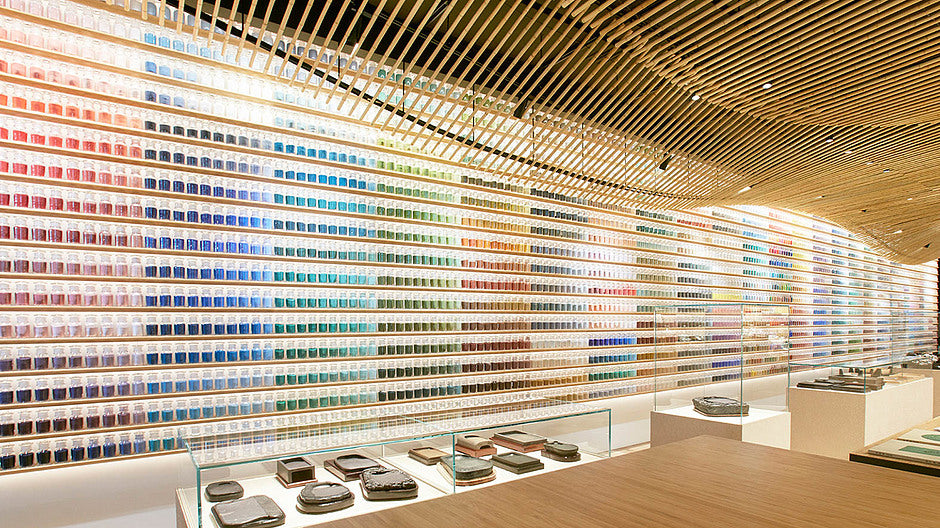―There are so many different colors lined up in PIGMENT TOKYO. How many colors are there?
In this shelf, there are over 4500 colors of pigments.
―Are they all made of different materials?
Yes, each color is made of different materials, and we have more than 4500 colors in total.

―These colors arranged in gradation, too?
These are the pigments called Iwaenogu (mineral pigments), which is made by pulverizing natural minerals or artificially made high fire glaze. They are divided according to the particle size, which creates the difference in colors from the same minerals. The coarser the particle size becomes, the darker the color becomes, and it becomes lighter as the particle size becomes finer.


―So, is everything here a mineral pigment?
Actually, natural pigments compose 70% in this shelf, and the rest of them are called effect pigment, which are normal pigments.
―Do you only sell pigments for Japanese paintings?
No. Although many people think so, these mineral pigments can be used for oil paintings and acrylic paintings, as well as Japanese paintings.
― Is it possible to paint directly with this pigment?
Well, no. The customers often ask us if they can mix the pigment with water. However, these bottled pigments are just a colored powder that becomes “a base of the paints”, so the final paint changes depending on what kind of medium you mix. For example, if you mix with animal glue, it will work for Japanese paints and oil for oil paintings, acrylic resin for acrylic paints and gum Arabic for watercolors. Therefore, basically, the name of the paints comes from the name of the medium that is used.
―I see. The combination of the pigments and medium allows creating different paints, does it?
That’s right. During the Renaissance period in Europe, artist added oil and eggs to the pigments and made their own paints.
―Did Da Vinci and Michelangelo also use mineral pigments then?
Well, not exactly mineral pigments, but they made paints from natural materials, as there were almost no artificial color at that time. In the time of Da Vinci and Michelangelo, colors such as vermillion, malachite green, azurite blue and yellow ocher were used. If we compare these colors to Japanese paintings, vermillion is called Honshu, malachite green is Rokusho, azurite blue is Gunjo, and yellow ocher is Odo.

―I see. That means they used the same materials, regardless of the country or region.
Exactly. As we go back in time, there is less difference in the pigments that was used.

―I did not know that. As I look at the right side of the shelf, there are vivid colors from the middle. Is it different from the mineral pigment?
These pigments were made a while before the Industrial Revolution and they are called synthetic inorganic pigments or organic pigments. Having said that, vermilion has used chemicals from long ago, and not all the pigments were born in the modern period. However, it was after the Industrial Revolution that the color increased explosively.

―Next to the pigments, I see the glittery pigments. Are they also relatively new?
Yes, they are called “effect pigment”. It uses latest technology, yet is historically very old. In Japan, we call it “Unmo” or “Kira”, and it is used for old picture scrolls too. Nowadays, various colors are created using different coating and structure where the color changes by the angle. Also, it can be used not only for paintings but also for the beauty products such as eye shadows and nail polishes and automotive paints.

―You have all the pigments that are indispensable for the various coloring.
Yes, we say 4500 colors not only for Japanese painting, but also as for the base of every color and collectively call them “pigments”.
To sum up, we have roughly three types of the pigments, which are mineral pigments, artificial pigments and effect pigments.
Please feel free to pick up and compare the colors, and find your favorite pigments.




